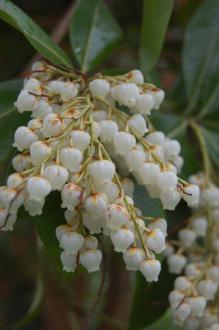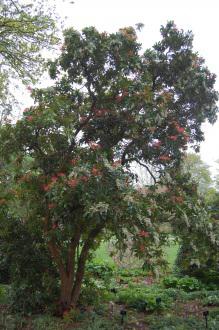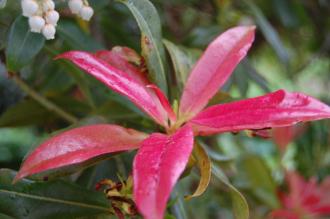
Pieris formosa var. forrestii ‘Wakehurst’ Flower (05/05/2012, Kew Gardens, London)
Position: Full sun to partial shade
Flowering period: Late spring
Soil: Moist, well drained
Eventual Height: 4m
Eventual Spread: 2.5m
Hardiness: 4b – 9a
Family: Ericaceae
Pieris formosa var. forrestii ‘Wakehurst’ is a vigorous, medium-sized evergreen shrub or small tree. Its dark green leathery leaves are lanceolate to ovate with serrulate margins, opposite and up to 12cm long. In spring the new leaves appear in whorls at the end of each shoot and are bright pink. Its cream/ white fragrant flowers are bell shaped, up to 15mm long, arranged in racemes or panicles and appear in the form of drooping sprays. Its fruit is a loculicidal capsules.

Pieris formosa var. forrestii ‘Wakehurst’ (05/05/2012, Kew Gardens, London)
The species Pieris formosa, commonly known as Himalayan Pieris, Andromeda and Lily of the Valley Shrub, is native to southwest Asia, Himalaya and north Burma. In its native habitat it grows in thickets on open slopes.
The etymological root of the binomial name Pieris is from the Greek Pierides, the surname of the goddesses of song. Formosa is from the Latin meaning ‘beautiful’, referring to the the flowers. The variety ‘Wakehurst’ is named after Wakehurst Palace, West Sussex.
The landscape architect may find Pieris formosa var. forrestii ‘Wakehurst’ useful as a medium sized shrub for planting in acidic soils, particularly in dappled shade.
Ecologically, P. formosa var. forrestii ‘Wakehurst’ is attractive to bees and pollinating insects. The leaves are the food of a number of moth larvae.

Pieris formosa var. forrestii ‘Wakehurst’ Leaf (05/05/2012, Kew Gardens, London)
The Royal Horticultural Society has given P. formosa var. forrestii ‘Wakehurst’ their prestigious Award of Garden Merit in 1993.
P. formosa var. forrestii ‘Wakehurst’ prefers moist, fertile, well-drained soils. It prefers an acidic pH of soil.
Pieris formosa var. forrestii ‘Wakehurst’ requires little maintenance.

